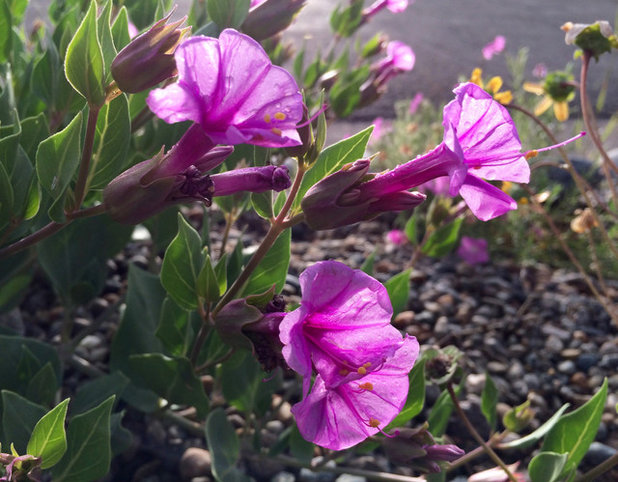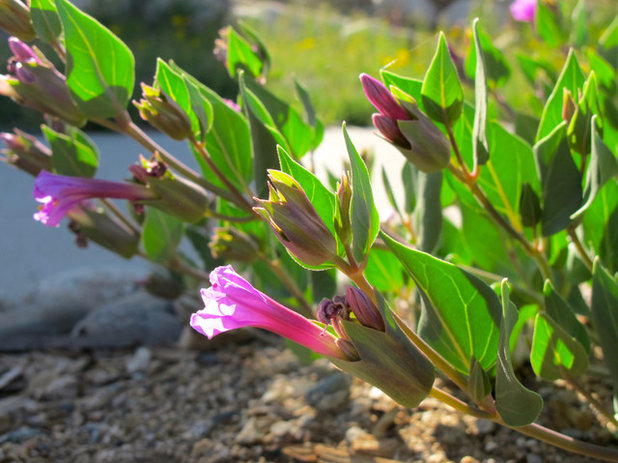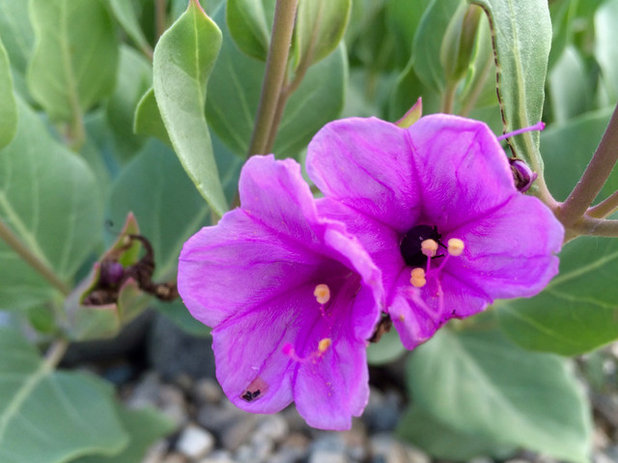Named for its afternoon-opening flowers, Colorado four o’clock (
Mirabilis multiflora) forms a long-lived, spreading mound in the hottest and most difficult garden sites. Trumpet-shaped blossoms in hot pink cover the plant from spring to early fall, attracting night-flying moths, butterflies, hummingbirds and native bees to their bounty of nectar and pollen.

Susan J Tweit
Botanical name: Mirabilis multifloraCommon names: Colorado four o’clock, desert four o’clock, showy four o’clock
Origin: Native from Colorado and Utah south to northern Mexico
Where it will grow: Hardy to minus 20 degrees Fahrenheit, or minus 28.9 degrees Celsius (USDA zones 5 to 9; find your zone)
Water requirement: None once established
Light requirement: Sun or very light shade
Soil requirement: Sandy, gravelly or clay; no amendments
Mature size: Up to 3 feet tall and wide

Susan J Tweit
Benefits and tolerances: Colorado four o’clock is long-lived, tolerant of poor soils and extremely drought-tolerant once established. Its branches provide erosion control, and its flowers provide nectar for the white-lined sphinx moth (
Hyles lineata), as well as hummingbirds and butterflies; native bees visit the blossoms for pollen and nectar too.
Seasonal interest: Attractive leaves that emerge in spring; hot pink buds and flowers in late summer and early fall; ghostly gray stems that offer architectural interest in fall
When to plant: Plant in spring and even summer after the danger of frost has passed since Colorado four o’clock is quite frost-tender when young.

Susan J Tweit
Distinguishing traits. The waxy leaves are heart-shaped to rounded and clasp the plant’s succulent stems in pairs. The stems are often reddish or tinged with pink and may be hairy. Colorado four o’clock’s trumpet-shaped flowers are hot pink to magenta, budding from a green cup of modified leaves. Even without flowers, the wide mound formed by the long stems is distinctive. After the flowers have bloomed, papery capsules contain the hard black seeds. Below the ground, the stems grow from a thickened taproot that looks like a pink parsnip and may grow quite fat, swelling to as much as a foot in circumference.
Edwin James, a member of U.S. Army Maj. Stephen Long’s expedition to the Rocky Mountains in 1820, made the first recorded scientific collection of this high-desert plant.
Mirabilis multiflora was originally given the unlovely name of
Oxybaphus multiflorus,
but that was changed by the great botanist Asa Gray to its current name in 1859.
Mirabilis, which means “wonderful” in Latin, is a tribute to the abundant magenta flowers.

Susan J Tweit
How to use it. Colorado four o’clock stands out in hot, difficult parts of the xeric landscape, from what gardeners call “hellstrip” locations between the street and the sidewalk to south- and west-facing slopes and rock gardens. It’s especially lovely paired with yellow-flowering composite flowers, such as lyreleaf greeneyes (
Berlandiera lyrata) and Rocky Mountain zinnia (
Zinnia grandiflora), as well as Indian ricegrass (
Achnatherum hymenoides), plains yucca (
Yucca campestris), clump-forming cactuses and other plants native to the arid pinyon pine-juniper woodlands where it grows naturally (shown here).
Colorado four o’clock has long been used medicinally, and for food and dye. Pulverized four o’clock roots dating from 2,000 years ago were excavated from a prehistoric site in the Sacramento Mountains of New Mexico. The Navajo still use four o’clock as a dye plant and make a tea from the leaves.
Planting notes. Young plants are frost-tender, so it’s best to plant them in spring. Cut back dead stalks on mature plants in late winter or early spring.
Browse more native plants by region





